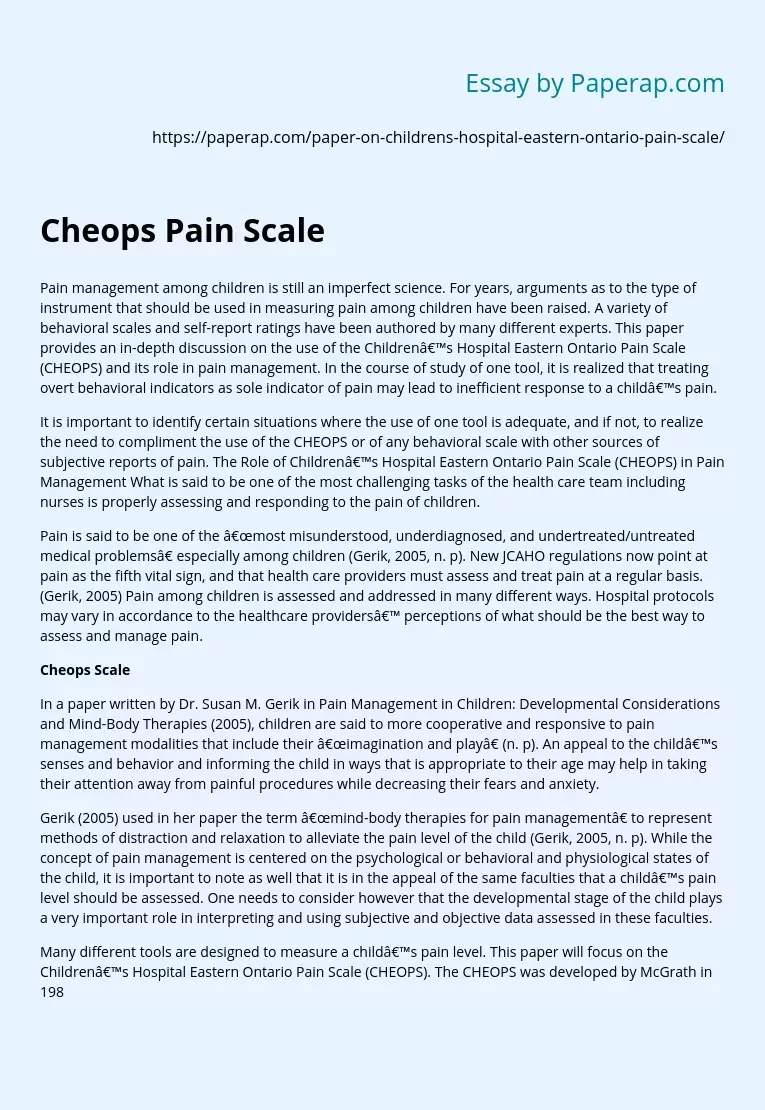Cheops Pain Scale
Pain management among children is still an imperfect science. For years, arguments as to the type of instrument that should be used in measuring pain among children have been raised. A variety of behavioral scales and self-report ratings have been authored by many different experts. This paper provides an in-depth discussion on the use of the Children’s Hospital Eastern Ontario Pain Scale and its role in pain management. In the course of the study of one tool, it is realized that treating overt behavioral indicators as sole indicator of pain may lead to inefficient response to a child’s pain.
It is important to identify certain situations where the use of one tool is adequate, and if not, to realize the need to compliment the use of the CHEOPS or of any behavioral scale with other sources of subjective reports of pain. The Role of Children’s Hospital Eastern Ontario Pain Scale in Pain Management What is said to be one of the most challenging tasks of the health care team including nurses is properly assessing and responding to the pain of children.
Pain is said to be one of the “most misunderstood, underdiagnosed, and undertreated/untreated medical problems” especially among children (Gerik, 2005, n. p). New JCAHO regulations now point at pain as the fifth vital sign, and that health care providers must assess and treat pain at a regular basis. (Gerik, 2005) Pain among children is assessed and addressed in many different ways. Hospital protocols may vary in accordance to the healthcare providers’ perceptions of what should be the best way to assess and manage pain.
Cheops Scale
In a paper written by Dr. Susan M. Gerik in Pain Management in Children: Developmental Considerations and Mind-Body Therapies (2005), children are said to more cooperative and responsive to pain management modalities that include their “imagination and play”. An appeal to the child’s senses and behavior and informing the child in ways that are appropriate to their age may help in taking their attention away from painful procedures while decreasing their fears and anxiety.
Gerik (2005) used in her paper the term “mind-body therapies for pain management” to represent methods of distraction and relaxation to alleviate the pain level of the child. While the concept of pain management is centered on the psychological or behavioral and physiological states of the child, it is important to note as well that it is in the appeal of the same faculties that a child’s pain level should be assessed. One needs to consider however that the developmental stage of the child plays a very important role in interpreting and using subjective and objective data assessed in these faculties.
Many different tools are designed to measure a child’s pain level. This paper will focus on the Children’s Hospital Eastern Ontario Pain Scale. The CHEOPS was developed by McGrath in 1985. It is a scale utilizing observation as a method, measuring the post-operative pain of children who are aged 1 to 17 years old. The term “behavioral scale” suggests that the data produced through this tool is objective in nature as an observer notes the overt behaviors of the assessed individual.
The scale has six items or categories: the child’s cry, facial expression, verbal complaints or positive verbalizations, activity of the torso, touch in relation to the wound area, and the position or activity of the legs. Each of these items is scored as 0, 1, or 2 in accordance to the child’s reactions. Take for example the first item, “cry. ” A score of 1 is given under this category if the caregiver observes that the child is not crying. On the other hand, if the child is in a “full lunged cry or is sobbing,” a score of 3 is given to the child.
Only the items or categories “facial and verbal” have the least possible score of 0. Once all six categories have been scored, the sum of all the scores is taken. The highest possible grade for each child assessed is 13, while the lowest is 4. A score that is greater than 4 is indicative of pain. In using the CHEOPS or any other instrument in this context, it is important to train the observer on the use of the scale to eliminate any bias or any other source of inconsistencies among raters.
Cheops Pain Scale. (2019, Dec 05). Retrieved from https://paperap.com/paper-on-childrens-hospital-eastern-ontario-pain-scale/

